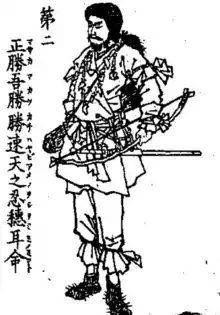Ame-no-oshihomimi
Amenooshihomimi (天之忍穂耳命)[1][2] or Oshihomimi for short, is the first son of Amaterasu.[3]
| Ameno‘oshihomimi-no-Mikoto | |
|---|---|
 | |
| Personal information | |
| Parents |
|
| Siblings | Ame-no-hohi (brother)
Amatsuhikone (brother) Ikutsuhikone (brother) Hinohayahi (brother) |
| Consort | Takuhadachiji-hime |
| Children | Ninigi-no-Mikoto |
He is believed to be the ancestor to the Japanese imperial family.[4]
Name and Etymology
Amenooshihomimi name means (Ruling Rice Ears of Heaven) goes by other names like Masakatsu-akatsukachi-hayahi-ame-no-oshihomimi which means (Truly Winning Have I Won with Rushing Might Ruling Grand Rice Ears of Heaven)[1]
Mythology
Birth
He was born out of a kami making competition between Amaterasu and Susanoo.
In many versions, Susanoo took Amaterasu’s beads and crushed them within his mouth, which created five male kami.[5][1] The first one to be born was Amenooshihomimi, second was Ame-no-hohi, third was Amatsuhikone, fourth was Ikutsuhikone, and Kumanokusubi was the firth. [3][6][7][8]
Offer to rule
In some versions, Amaterasu gave Amenooshihomimi a bronze mirror and this mirror, called Yata no Kagami.[9] In many versions, Amenooshihomimi is the first to be offered as the ruler of earth however, he turns it down.[10][11]
He fell in love with Takuhadachiji-hime, and then later on fathered Ninigi-no-Mikoto.[12][13]
See also
References
- "Amenooshihomimi • A History of Japan - 日本歴史". A History of Japan - 日本歴史. Retrieved 2020-09-28.
- "[Soul of Japan] The Divine Age of Shinto". JAPAN Forward. 2019-11-02. Retrieved 2020-09-29.
- Havens, Norman; Inoue, Nobutaka (2006). An Encyclopedia of Shinto (Shinto Jiten): Kami. Institute for Japanese Culture and Classics Kokugakuin University. ISBN 978-4-905853-08-4.
- Isomae, Jun'ichi; Subramanian, Mukund (2016-04-08). Japanese Mythology: Hermeneutics on Scripture. Routledge. ISBN 978-1-134-94908-3.
- https://www.google.com/books/edition/A_Study_of_the_Origin_of_the_Japanese_St/H18tAAAAYAAJ?hl=en&gbpv=1&dq=Amaterasu+and+Susanoo+oath&pg=PA66&printsec=frontcover
- http://eos.kokugakuin.ac.jp/modules/xwords/entry.php?entryID=33
- https://books.google.com/books?id=Q5cqAQAAIAAJ&q=Amatsuhikone
- "Encyclopedia of Shinto - Home : Kami in Classic Texts : Kumanokusubi". eos.kokugakuin.ac.jp. Retrieved 2020-10-07.
- Jones, Lindsay (2005). Encyclopedia of religion. Macmillan Reference USA. ISBN 978-0-02-865734-9.
- Roberts, Jeremy (2009). Japanese Mythology A to Z. Infobase Publishing. ISBN 978-1-4381-2802-3.
- 成蹊大学文学部紀要 (in Japanese). 成蹊大学文学部. 1977.
- Picken, Stuart D. B. (2010-12-28). Historical Dictionary of Shinto. Scarecrow Press. ISBN 978-0-8108-7372-8.
- "Encyclopedia of Shinto - Home : Kami in Classic Texts : Ninigi". eos.kokugakuin.ac.jp. Retrieved 2020-09-28.
| Mythology |
|---|
| See also |
| List of mythologies |